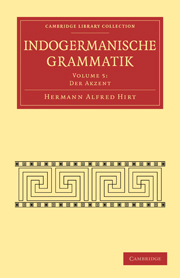Book contents
- Frontmatter
- Vorwort
- Contents
- Einleitung
- Erster Teil. Der Akzent der Einzelsprachen
- Zweiter Teil. Der Akzent des Indogermanischen
- XVI Kapitel. Die Intonation (der Silbenakzent)
- XVII Kapitel. Derindogermanische Wortakzent (Hauptton)
- XVIII Kapitel. Typus mit wechselndem Ton
- XIX Kapitel. Nomina mit festem Ton
- XX Kapitel. Betonung der Adjektiva
- XXI Kapitel. Adverbium. Zahlwort. Pronomen
- XXII Kapitel. Betonung des Verbs. Vorbemerkungen
- XXIII Kapitel. Die einzelnen Betonungstypen des Verbums
- XXIV Kapitel. Der zweite Betonungstypus
- XXV Kapitel. Der dritte Betonungstypus
- XXVI Kapitel. Der Satzakzent. Vorbemerkungen
- XXVII Kapitel. Enklise und Proklise
- XXVIII Kapitel. Betonung der Wortgruppen
- XXIX Kapitel. Die weitere Satzbetonung
- Autorenverzeichnis
- Sachregister
- Wörterverzeichnis
XXI - Kapitel. Adverbium. Zahlwort. Pronomen
Published online by Cambridge University Press: 05 August 2011
- Frontmatter
- Vorwort
- Contents
- Einleitung
- Erster Teil. Der Akzent der Einzelsprachen
- Zweiter Teil. Der Akzent des Indogermanischen
- XVI Kapitel. Die Intonation (der Silbenakzent)
- XVII Kapitel. Derindogermanische Wortakzent (Hauptton)
- XVIII Kapitel. Typus mit wechselndem Ton
- XIX Kapitel. Nomina mit festem Ton
- XX Kapitel. Betonung der Adjektiva
- XXI Kapitel. Adverbium. Zahlwort. Pronomen
- XXII Kapitel. Betonung des Verbs. Vorbemerkungen
- XXIII Kapitel. Die einzelnen Betonungstypen des Verbums
- XXIV Kapitel. Der zweite Betonungstypus
- XXV Kapitel. Der dritte Betonungstypus
- XXVI Kapitel. Der Satzakzent. Vorbemerkungen
- XXVII Kapitel. Enklise und Proklise
- XXVIII Kapitel. Betonung der Wortgruppen
- XXIX Kapitel. Die weitere Satzbetonung
- Autorenverzeichnis
- Sachregister
- Wörterverzeichnis
Summary
Adverbia. Adverbia sind schon verschiedentlich zur Sprache gekommen. Doch müssen sie auch noch zusammenfassend behandelt werden.
Es gibt zwei Arten von Adverbien. Es sind z. T. erstarrte Kasusformen, und als solche haben sie öfter eine ältere Form oder eine ältere Betonung bewahrt als die Formen. zu denen sie gehören. Anderseits treten zur Bildung der Adverbien besondere Elemente an den Stamm, z. T. auch solche, die wir sonst nicht kennen.
Ganz scharf sind die beiden Arten nicht zu trennen.
Erstarrte Kasus.
1. Als Adverbium wird der bloße Stamm, der Kasus indefinitus, verwendet, der gleich dem Neutrum ist.
So bei den u-Stämmen. Hier hat sich auch die alte Wurzelbetonung erhalten. Vgl. gr. εὖ: ἐύς; got. filu: gr. πολύς. Oben S. 268.
An diese Form auf -u sowie an andere derartige Formen tritt das Element -om, das teils betont, teils unbetont ist.
Hierher zunächst gr. πολλόν < *polw-óm; ἐτε(F)όν, nur dies bei Homer, zu ἐτεός, vgl. ἔτυμον und Ntr. ἐτά Hes. < *etwá.
Es ist möglich, daβ die Adjektiva auf -wom aus einem solchen Adverb auf -om entwickelt sind.
Weiter finden wir Endbetonung in
gr. δηρόν ‘lange’, καλ-όν, μακρόν, wohl auch in πλησίον, ἀντίον (§ 24) und den Adverbien auf -δόν, ai. nūnám ‘jetzt’, ēvám ‘so’, kathám ‘wie’, itthám ‘so’, pratarám ‘früher’, sākám ‘zusammen’, ēkakám: ēkás ‘eines’, ānūkám ‘nach der Reihe’.
- Type
- Chapter
- Information
- Indogermanische Grammatik , pp. 284 - 293Publisher: Cambridge University PressPrint publication year: 2009First published in: 1929



